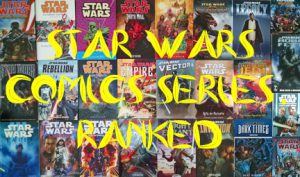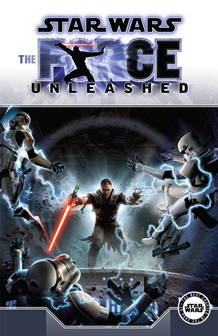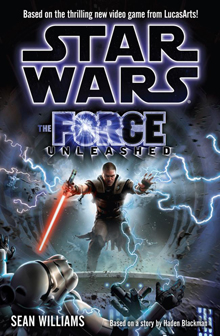“The Force Unleashed” (2008) – the multimedia project highlighted by a video game, novel and comic — despite being a fairly recent endeavor, is among the first Legends material to be wiped out by the new Disney canon (specifically “Rebels”). (It’s also back in the spotlight because fans continually say “The Force Unleashed” instead of “The Force Awakens” when referring to the upcoming movie.) But its canonicity was always a bit confusing.
The most notable aspect of the story is that it chronicles the formation of the Alliance to Restore the Republic. Game and comic writer Haden Blackman and novelist Sean Williams stay true to the Corellian Treaty, first mentioned by Timothy Zahn in “Dark Force Rising,” where Bail Organa (wealth), Mon Mothma (soldiers) and Garm Bel Iblis (fleet) combine their distinct areas of expertise into a formal military rebellion. Bail notes on page 296 of the paperback that “We’ve been working at cross-purposes for years now, waiting for that catalyst that would bring us together.” (The catalyst is the main character of “The Force Unleashed,” the Force-wielding Starkiller — often called “the apprentice,” and actually named Galen Marek.)
In a cool twist, “TFU” reveals that the Emperor (via Vader, and via Starkiller) forms the Alliance for the purpose of having all his enemies in one spot. Palpatine intends to kill Bail and his cohorts – “Your very public and painful executions will crush any dissent. Any hope of rebellion dies with you,” the Emperor tells Bail. After Galen foils the plot and the Rebels escape, Palpatine briefly worries that “if even a single rebel survives, this alliance we have unwittingly created will be our undoing.”
I think Blackman and Williams missed an opportunity here to explore the theory that “war is the health of the state” (first attributed to writer Randolph Bourne). The prequels show how Palpatine uses war to rise to power, so it might’ve been neat to see him use perpetual war to maintain his power. Williams at least throws in an additional line that explains why Palpatine backs off on his plan to wipe out the Rebellion’s founders (after all, Bail is still an Imperial senator up until Alderaan’s destruction, and Mon Mothma and Bel Iblis survive the entire war): “Patience, Lord Vader. Far better to destroy a man’s hope first. Or that of someone close to him …” (an allusion to Bail’s daughter, Leia). (This strategy of playing on an individual’s fears for their loved ones also explains the subjugation of the physically imposing Wookiees as slave labor in the construction of the Death Star, which is seen in the novel.)
While “TFU’s” chronicle of the Alliance’s formation doesn’t necessarily contradict Matthew Stover’s 2005 novelization of “Revenge of the Sith,” where Bail, Mon Mothma and Bel Iblis (along with Padme and others) form a secret pact, it sure would’ve been nice if “The Force Unleashed” had mentioned this alliance from 18 years earlier, rather than implying that three completely separate rebellions “working at cross-purposes” were merging together for the first time. Of course, it’s no fault of Blackman that he doesn’t mention the Onderon rebels (strongly implied to be spiritual ancestors of the Alliance), as they weren’t introduced until a 2012 arc on “The Clone Wars,” or the Ghost crew, the titular “Rebels” from the animated series that started this fall.

“Rebels” also slightly contradicts Bail’s claim to be merely the wealth behind the Alliance, as he is gathering and sharing intelligence with small rebel factions – notably Hera and her Ghost crew, of course – in the series, which takes place five years before “A New Hope” on the Disney timeline (whereas “The Force Unleashed” is two years before “ANH” on the Legends timeline). It’s also interesting to note that the Rebel Alliance’s Starbird symbol comes from Galen Marek’s family in “The Force Unleashed,” whereas “Rebels” features a slight variation on the symbol being painted as graffiti by Sabine Wren. This is the primary reason why Legends’ “TFU” and Disney’s “Rebels” can’t be ret-conned with each other.

But as I noted, “TFU” had continuity oddities even before it became Legends. Notably, in the cliffhanger to Part 1 of the novel, Vader “kills” his apprentice by stabbing him through the stomach with a lightsaber then blowing him out into space. At the start of Part 2, Galen is physically and mentally fine (albeit psychologically scarred). Vader has apparently used Imperial technology to resurrect him (he says he needed the Emperor to believe Galen was dead, but really it was just Vader’s latest step in forging the young man into a powerful dark-side weapon).
Four theories for Galen’s resurrection come to mind, but none of them quite clicks:
1. Galen can’t have been completely healed by Imperial technology after having his innards ripped up by a lightsaber and exposure to vacuum, because if the tech were truly that advanced, Vader himself would take advantage of it rather than using a cumbersome life-support suit. (Nonetheless, I believe this explanation is what Blackman intended.)
2. Galen can’t have transferred his essence into a clone body, because the story is told from his point of view and we know he doesn’t do that. The Emperor transfers his essence into a clone in “Dark Empire,” but he is fully aware he’s doing it.
3. Neither Vader nor the Emperor could’ve used the Force to keep Galen from dying, because neither has mastered that ability. Darths Tenebrous and Plagueis experimented with the art of keeping people from dying, but didn’t master it. Darth Sidious used the concept as a lure to turn Vader to the dark side, and while he later kept himself from dying (“Dark Empire”), he couldn’t perform the same trick for others. If Palpatine did restore Galen to perfect health off-page and off-panel, it should’ve made Vader angry that he didn’t perform this same trick for himself or for Padme.
4. While it’s not exactly the same as bringing someone back from death, the Emperor is able to transfer people’s essences into a clone body using Sith alchemy, as he does with Death Star designer Bevel Lemelisk in flashback scenes in the novel “Darksaber.” So he theoretically could’ve done this with Galen. Indeed, it is a more satisfying explanation than the catch-all “Imperial technology” that Blackman and Williams give us. But without any hint in the narrative of Palpatine performing this feat on Galen, it’s probably not what the author intended.
Galen later (seemingly) dies in the story’s finale, but then returns as the star of 2010’s “The Force Unleashed II” (also a game-novel-comic trifecta). As such, his repeated mysterious resurrections are the unavoidable thematic thrust of that sequel. Another character who suggests Blackman intended a sequel is the Zabrak Jedi Padawan Maris Brood. When Galen kills her master, Shaak Ti, Maris embraces the powerful dark side energy of Felucia and turns evil; in a second encounter, Galen lets Brood go off into the jungles rather than killing her. (Despite this setup for future stories, and her popularity among fans, Maris doesn’t appear in the sequel!)
Despite these dangling threads, Williams writes a smooth-flowing novel. I feared it would be too video-gamey, with endless action sequences. While there is some of that, Williams does a good job of portraying Galen: He has been trained in the dark side by Vader, but that’s all he knows, and when exposed to the light side, he’s intrigued by an option he didn’t know existed (that’s how I reconcile the relative ease of his turn from evil to good). His pilot, Juno Eclipse, goes through a similar arc: She has only known life with the Empire, but when branded a traitor by Vader (for under-explained reasons), she must forge a new life. I like how Williams builds the Galen-Juno romance without being heavy-handed; the same goes for the friendship between Galen and his droid, PROXY.
I’d recommend reading the comic after the novel, as it is told with the framing mechanism of Bail and Juno debriefing each other on the events of the novel, trying to assure themselves – for logistical and personal reasons — that Galen was a good guy.
Ultimately, “The Force Unleashed” can’t shake its origin as a video game where Starkiller blows away platoons of stormtroopers with the Force, guides a Star Destroyer to crash into an Imperial base and wields Force lightning as if he’s firing a blaster. Those things are there because they look cool. But with that in mind, Blackman and Williams forge a surprisingly decent character drama with neat revelations (now contradicted) about the Alliance’s formation.

